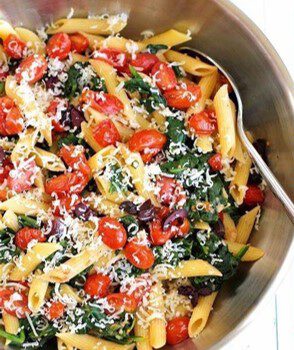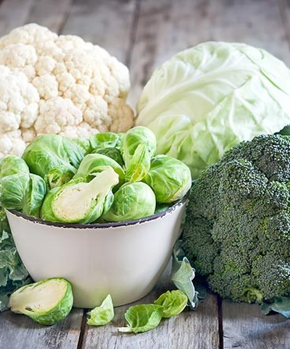In recent years, emerging research has confirmed the benefits of this unique family of plants, with studies showing that cruciferous vegetables host an impressive array of antioxidants, nutrients, and sulfur-containing compounds, all of which are responsible for their potent medicinal and health properties.
Cruciferous vegetables are any type of vegetable in the Brassicaceae family of plants, also known as the Cruciferae family. The name is derived from the New Latin word for “cross-bearing,” which is due to the crosslike shape of the four petals found in many species.
Cruciferous vegetables are low-calorie and rich in fiber, folate, vitamins A, C, and K, potassium, and phytonutrients such as sulforaphane. In addition, cruciferous vegetables contain a group of substances known as glucosinolates, which are sulfur-containing chemicals. These chemicals are responsible for the pungent aroma and bitter flavor of cruciferous vegetables.
Cruciferous vegetables include:
- Arugula
- Bok choy
- Broccoli
- Brussel sprouts
- Cabbage
- Cauliflower
- Chard
- Chinese cabbage
- Collard greens
- Daikon radish
- Horseradish
- Kale
- Kohlrabi
- Mustard greens
- Radishes
- Rutabagas
- Turnips
- Watercress
Some research shows that regular consumption of cruciferous vegetables may be associated with reduced risk of several types of cancers, especially stomach, colon, rectal, and lung cancers. It may be linked to a lower risk of bladder, breast, prostate, ovarian, and endometrial cancers as well.
Cruciferous vegetables can be prepared and enjoyed in a variety of ways as part of a well-rounded meal, snack, or side dish.
- Broccoli, for example, can be steamed, roasted, baked, or boiled and added to stir-fries, casseroles, stews, and slaws.
- Leafy greens such as kale, cabbage, and arugula can be enjoyed as a base for salads or used in omelets, pasta dishes, pizza, and smoothies.
- Brussels sprouts often are roasted or sauteed and paired with honey, balsamic vinegar, nuts, or lemon juice to help balance their flavor.
- Cauliflower is a popular low-carb, low-calorie alternative to other ingredients such as rice, grains, and potatoes.
The versatility of cruciferous vegetables lends themselves well when added to smoothies, sandwiches, salads, and soups for a quick and convenient way to take advantage of the many health benefits these vibrant vegetables have to offer.
Here are some recipes to help you explore cooking with cruciferous vegetables!
Pasta with Tomatoes, Kale, and Olives
Ingredients:
- 1/4 c. vegetable broth
- 1 onion
- 2 garlic cloves, minced (rest 10 min. before cooking)
- 5 c. chopped kale
- 2 cans chopped fire-roasted tomatoes
- 1/2 c. sliced kalamata olive
- 1 T. chopped fresh parsley
- 8 oz. whole wheat penne
- 1/4 c. Parmesan cheese
Directions:
- Heat vegetable broth in a large saucepan. Add onions and garlic, stir over medium heat for 3 minutes. Add kale and tomatoes. Bring to boil, lower the heat, cover, and simmer for 20 minutes. Stir in olives and parsley and cook for 5 minutes longer.
- Cook penne according to package directions. Drain and transfer to large serving bowl. Add kale mixture and toss.
- Sprinkle with Parmesan cheese. Serve.
Roasted Cruciferous Vegetables
Ingredients:
- 2 cups cauliflower florets
- 2 cups broccoli florets
- 2 cups Brussels sprouts, halved
- ½ cabbage, chopped
- 3-4 cup kale, chopped into bite-sized pieces
- 2 cloves garlic, minced
- 1 cup vegetable broth
- 1 tsp. ground coriander
- Juice of 1 lemon
- Olive oil as needed
- Salt and pepper to taste
Instructions:
- Place cauliflower, broccoli and Brussel sprouts in a large bowl and drizzle with 1 Tbsp. olive oil. Stir to coat, and sprinkle with salt and pepper.
- Place vegetables on a large sheet pan and place in a 375º oven, roast for 30-40 minutes, or until vegetables are tender.
- While the vegetables are roasting, add 2-3 tsp. olive oil in a large skillet. Add the garlic and sauté on medium heat for 30 seconds.
- Add cabbage and kale and ½ c. vegetables broth. Cover and cook for 4-5 minutes stirring occasionally.
- Add roasted vegetables to cabbage and kale, add coriander and stir together.
- Add lemon juice and the other ½ c. vegetable broth, stir and serve hot.
Buffalo Cauliflower
Ingredients:
- Olive oil cooking spray
- 1 cup water
- ¾ cup all-purpose flour
- ½ tsp. garlic powder, or to taste
- Salt and ground black pepper to taste
- 2 heads cauliflower, cut into bite-sized pieces
- 2 Tbls. Butter
- ½ cup hot pepper sauce (such as Frank’s RedHot©)
- 1 tsp. honey
Instructions:
- Preheat oven to 450º. Lightly grease a baking sheet with cooking spray.
- Whisk together water, flour, garlic powder, salt, and pepper in a large bowl until batter is smooth and somewhat runny.
- Add cauliflower pieces to batter and mix until evenly coated; spread onto the prepared baking sheet.
- Bake in preheated oven until browned, 20-25 minutes. Set them aside.
- Melt butter in a saucepan over medium heat. Remove from heat; stir in hot pepper sauce and honey until smooth.
- Brush hot sauce mixture over each cauliflower piece, repeating until all are coated.
- Return to the oven and bake until cauliflower is browned, about 10 minutes.
- Let cool for 10-15 minutes before serving.







